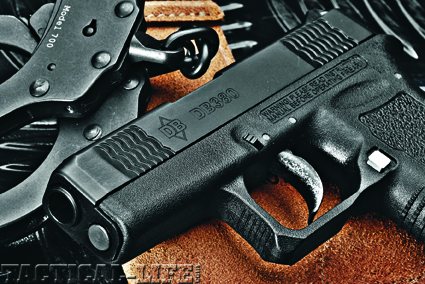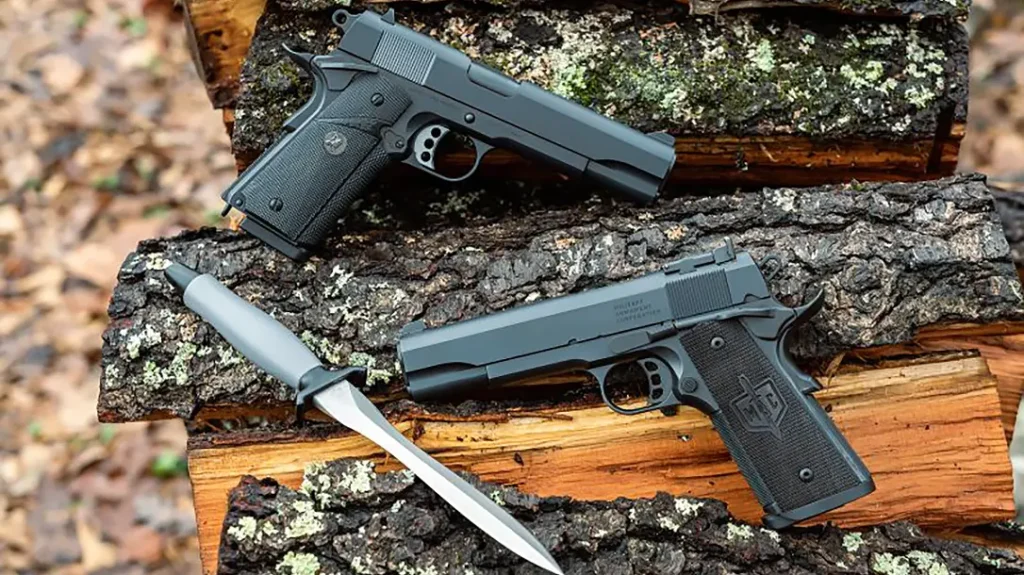The DB380 use reptile-like cocking serrations fore and aft. For deep cover concealment the slim and petite dimensions of the DB380 will be hard to beat.
For undercover law enforcement professionals the choice of a weapon is often dictated by elements beyond the control of the officer. Unfortunately, their weapon selection often involves sacrificing power for size to aid in concealment. It is a compromise that sometimes can undermine confidence and ultimately the UC’s effectiveness.
In the past couple years there have been a number of gun manufacturers that have made an effort to reduce the girth of their pistols by offering slimmed down versions. Thinner guns are easier to carry and conceal, and those whose lives depend on these guns applaud this move. Most use polymer frames and single stack magazines with a reduced capacity. I favor the slimmer guns over the fatter guns with double-digit capacities. In the deep concealment role or even as a backup, the reduction of capacity versus girth is a compromise that I will gladly make.
Advertisement — Continue Reading Below
One of the newest entries into the defensive firearms market is Diamondback Firearms’ DB380. Measuring just 0.75 of an inch thick and weighing a mere 8.8 ounces, the new pistol, from Diamondback Firearms LLC possesses a Double-Action-Only (DAO) trigger and a 6 + 1 capacity of .380 ACP ammunition. Its petite dimensions and light weight will undoubtedly not only make it a hit with the concealed carry market but also those that are looking for a thin pistol that can be used for LE deep concealment or backup.
Diamondback uses a glass-reinforced polymer for the DB380 frame. It’s lightweight, durable and completely corrosion resistant. It features texturing for a secure firing grip and dimples on each side for consistent indexing. The tang at the rear of the frame also protects the shooter from being bitten by the slide. Internal parts are pinned into the frame including stainless steel rails that the slide runs on so that there is no metal to plastic contact that might wear quickly.
At first glance the grip appears to be at an uncomfortable right angle to the slide. I predicted that I would hate the way it feels before I even picked it up. I was wrong. Its curved backstrap positions the gun very comfortably in the hand. Additionally, the triggerguard is relieved where it meets the frontstrap and allows the knuckle of the third finger to ride higher.
Advertisement — Continue Reading Below
The gun sits very low in the hand thanks to the DB380’s excellent ergonomics. Its trigger bars ride next to the barrel lug instead of under it thereby reducing the height of the pistol. The low bore-to-hand angle helps negate muzzle flip. The gun recoils straight back into the hand rather than up at the muzzle. Quick follow up shots are possible.
Diamondback literature mentions that both the slide and barrel are “Through Hardened.” Diamondback’s Brad Thomas explained that they buy their materials already hardened rather than machining the steel and sending the parts out for heat treatment that can cause distortion or warpage. After machining the parts are finished in a matte, non-reflective black. Thomas said, “We use a hot salt bath, similar to Glock’s Tenifer, and the finish bonds with a hard shell to the steel.”
Diamondback machines reptile-like cocking serrations into the front and rear of their DB380 slide. Caution must be used if the shooter uses the forward cocking serrations as they could potentially place part of the hand in front of the muzzle. All edges of the slide have been nicely rounded to prevent cutting the hand or skin. This feature will be appreciated if the gun is secreted in an unusual position or directly against the skin.
Advertisement — Continue Reading Below
Zero Energy Striker
There is no manual safety on the DB380. Instead it was designed to be safe with its DAO trigger. The length of pull is about 0.50 of an inch and is very smooth. My test sample’s trigger breaks at about 5.5 pounds. One of the DB380’s unique features is its patented zero energy striker. According to Thomas, “We patented the way that our striker system functions. It is what we call a zero energy striker system. Most striker-fired guns like the Glock or Kahr use a striker that is held with spring tension. Ours is not — there is no spring tension on the striker until you pull the trigger. If something were to fail, even though there is a firing pin block, there’s no spring tension on the firing pin to drive it into the primer.” As Thomas mentioned, there is a mechanical block to the striker that precludes it making contact with the cartridge’s primer unless pressure is placed on the trigger.
The DB380’s unusually smooth trigger is owed to its dual trigger bar design. This design prevents any binding. But it also precluded the inclusion of a slide stop. Thomas said, “Honestly, after we designed the dual trigger bar and got everything fit into it we wanted to incorporate one but there just isn’t enough room. It became about sacrifices — what do we have to sacrifice to get one and is it worth the extra problems? We weren’t willing to sacrifice the things that we needed to add the slide stop. For everyday shooting or carrying around in your pocket you don’t need a slide stop.” For its intended role I do not see the exclusion of the slide stop as detrimental.
The DB380 uses a dual spring recoil system. There is a smaller guide rod with a small diameter spring wrapped around it and a larger diameter cap with a flange upon which a larger diameter spring is wound, in the opposite direction. Though it gives the pistol enough spring mass to handle virtually any .380 round, it is still easy to hand cycle and chamber a round manually. There is a large claw type external extractor used on the DB380.
Advertisement — Continue Reading Below






















